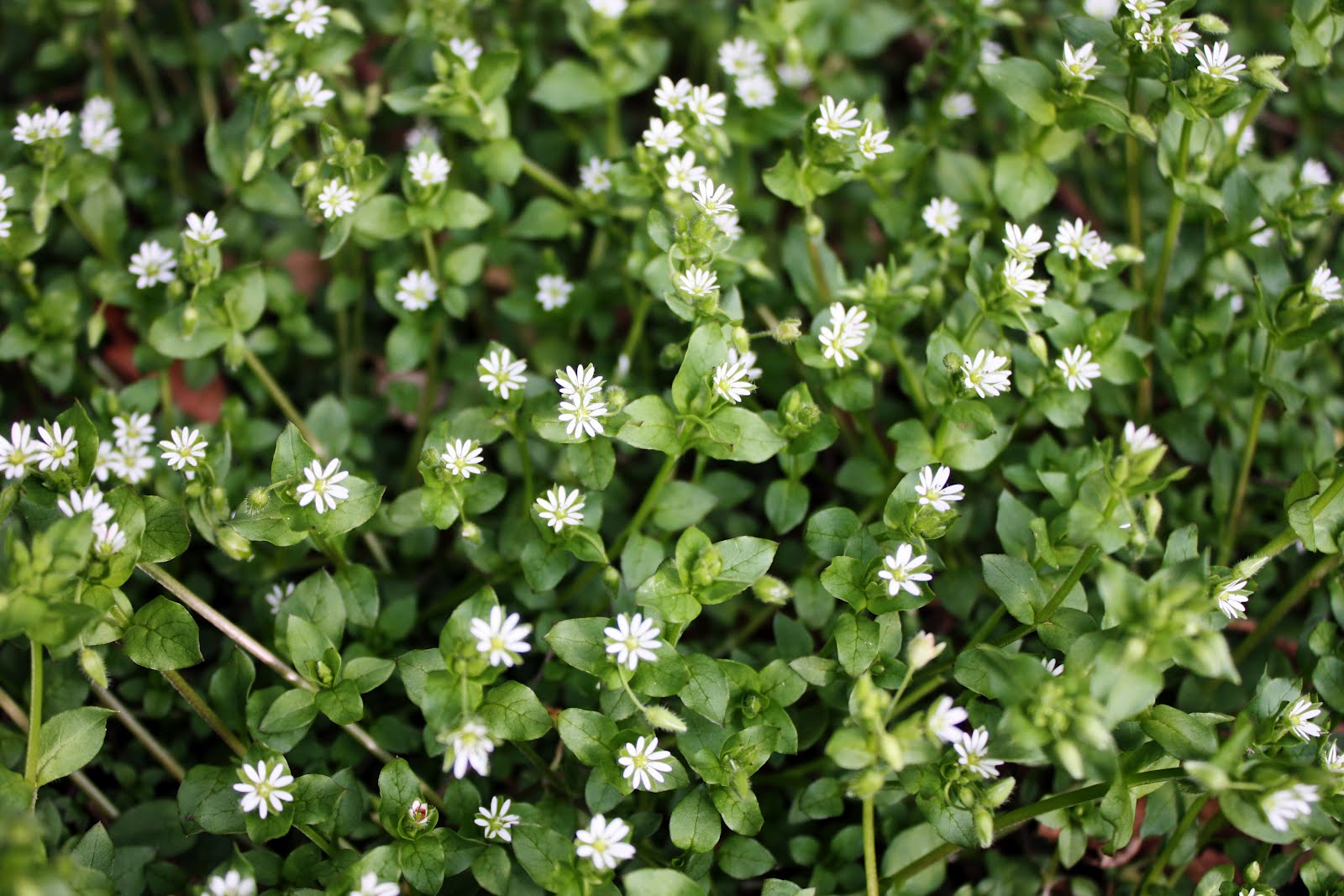Amy Brodish
Clinical Herbalist
(4/2014) Stellaria media is an annual plant, in the Caryophyllaceae family, usually found March through September. Its appearance could be considered unobtrusive and dainty, yet its personality speaks of persistence. The weak, straggling stems have fine hairs along one side of the stem. The angle of the hairs change at each node. The leaves are
opposite and elliptical to egg-shaped with a pointed end. The roots are shallow, making it easy to pull. The star-like white flowers occasionally have a slight tinge of pink and measure about 3-6 mm. While it appears to have ten petals, the flowers actually consist of five petals and five longer sepals. The flowers tend to close during evening hours and on cloudy or rainy
days. It is abundant in our area, though many consider it a nuisance weed, as it very easily propagates itself from its numerous seeds.

Although, when we look at Chickweed’s nutritional and healing properties, this plant is far from a nuisance or a mere weed. Chickweed is a very nutritious herb, containing Vitamins A, B1, B2, B3, C, E along with Calcium, Copper, Iron, Magnesium, Manganese, Phosphorous, Potassium, Selenium, Silicon, Sodium, Sulfur and Zinc plus essential fatty acids.
Many cultures enjoy the leaves and stems as a common food. It can be eaten as a salad vegetable or cooked and eaten like cabbage. The cooking water can be drank or used topically. The greens can be dried to use during the winter months as tea. It can also be decocted by combining one ounce of the dried herb or two ounces of the fresh herb with 1 ½ pints water in stainless
steel cookware and bringing to a slow boil until the water reduces to about one pint. Additionally, the fresh greens can be blended into a smoothie or juiced with a wheat grass juicer. For convenience, it can also be made into an ointment or tincture. Furthermore, for those who may have caged birds, Chickweed is a nutritious treat that they greatly appreciate and enjoy.
Gathering Chickweed is best just as it starts to flower, since the stems toughen during the growing season. The tops can be pinched off, allowing the plant to grow back and provide more tender greens. Before gathering any plants, be certain that you have positively identified the correct plant with a field guide and gather from an area far from roads
that have not been in contact with herbicides, pesticides, fungicides, synthetic fertilizers or other harmful substances, including vehicle exhaust fumes.
All of the above ground parts have been used in herbal medicine for many years due to claims of the following properties: mild antiseptic, mild diuretic, laxative, pectoral (for lung complaints), demulcent and emollient, expectorant, nutritive, anti-inflammatory, blood cleansing, ability to dispel or dissolve abnormal growths, anti-rheumatic and
cooling. Chickweed has also been reputed to curb obesity and scientific studies confirm such action. Another study shows that the seeds exhibit antimicrobial and antifungal activity.
Chickweed has also been employed to soothe rheumatic pains, for skin diseases and eruptions, to alleviate burning and itching, draw out splinters, heal wounds and scalds, remove mucous, clear blood poisoning, counteract scurvy, reduce inflammation of all sorts as well as relieving sore eyes, sore throats and coughs. It also was used to fade freckles.
Chickweed has been used historically for cancers, tumors, abscesses, cysts, hemorrhoids, bleeding of bowels or lungs, abraded nasal passages, peritonitis, appendicitis, St. Anthony’s Fire, conjunctivitis, gastrointestinal weakness, asthma, bronchitis, consumption, pleurisy and for liver issues including hepatic torpor and hepatitis. A scientific study shows Chickweed has
diverse antiviral activity, including potential for anti-hepatitis B activity (Ma, et.al.) and another study concluded that Chickweed has hepatoprotective (liver protective) activity. (Gorina, et.al.)
Quite an impressive reputation for an often-overlooked weed, considered a nuisance by many, isn‘t it?
Amy is graduated from the American College of Healthcare Sciences as a Master Herbalist, and is a Certified Natural Health Professional and owner of Herbal Reflections in Fairfield, Pennsylvania. She holds consultations with clients interested in improving their health naturally and is available for seminars. Amy also prepares personalized herbal
formulations and flower essences for clients. She may be reached through 717-642-5000, www.herbalreflections.com, or amy@herbalreflections.com.
Read other articles by Amy Brodish